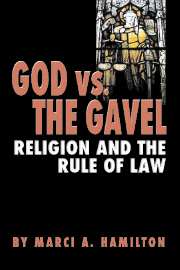Book contents
- Frontmatter
- Contents
- Acknowledgments
- Foreword, by the Hon. Edward R. Becker
- GOD VS. THE GAVEL: RELIGION AND THE RULE OF LAW
- PART ONE WHY THE LAW MUST GOVERN RELIGIOUS ENTITIES
- 1 The Problem
- 2 Children
- 3 Marriage
- 4 Religious Land Use and Residential Neighborhoods
- 5 Schools
- 6 The Prisons and the Military
- 7 Discrimination
- PART TWO THE HISTORY AND DOCTRINE BEHIND THE RULE THAT SUBJECTS RELIGIOUS ENTITIES TO DULY ENACTED LAWS
- Epilogue
- Notes
- Index
5 - Schools
Published online by Cambridge University Press: 24 July 2009
- Frontmatter
- Contents
- Acknowledgments
- Foreword, by the Hon. Edward R. Becker
- GOD VS. THE GAVEL: RELIGION AND THE RULE OF LAW
- PART ONE WHY THE LAW MUST GOVERN RELIGIOUS ENTITIES
- 1 The Problem
- 2 Children
- 3 Marriage
- 4 Religious Land Use and Residential Neighborhoods
- 5 Schools
- 6 The Prisons and the Military
- 7 Discrimination
- PART TWO THE HISTORY AND DOCTRINE BEHIND THE RULE THAT SUBJECTS RELIGIOUS ENTITIES TO DULY ENACTED LAWS
- Epilogue
- Notes
- Index
Summary
The public school system was initiated with religious dispute, and religious accommodation conflicts continue to today. Public schools were originally instituted by a Protestant majority and reflected Protestant religious viewpoints, including mandatory daily readings from the King James Bible. In the early 1820s, New York started funding schools, and by 1840, some Catholics were objecting to the Protestant religious curriculum. As Professor Philip Hamburger recounted in his excellent book, Separation of Church and State, the early public schools started with indoctrination in a Protestant perspective. Moreover, they protected their turf, by denying funding to “sectarian” schools (as though the Protestant public schools were not sectarian), “including Baptist, Methodist and Catholic.” Over the succeeding years, the political will to prevent funding for any schools other than the Protestants' was distilled into an antifunding drive aimed mainly at Catholics.
A significant number of Christians in the United States might be tempted to latch onto the early Protestant practices in the schools as proof that the schools should now reintroduce prayer and religion in the schools. They would argue that public education has been corrupted, because prayer and Bible reading have been excised. The Rev. Jerry Falwell, following 9/11, remarked: “We have seen the course of secularism in our schools, and it is obviously time for a change. It is high time our nation once again favors its people of faith by allowing our public-school students to be exposed to prayer and the pursuit of faith.”
- Type
- Chapter
- Information
- God vs. the GavelReligion and the Rule of Law, pp. 111 - 140Publisher: Cambridge University PressPrint publication year: 2005



